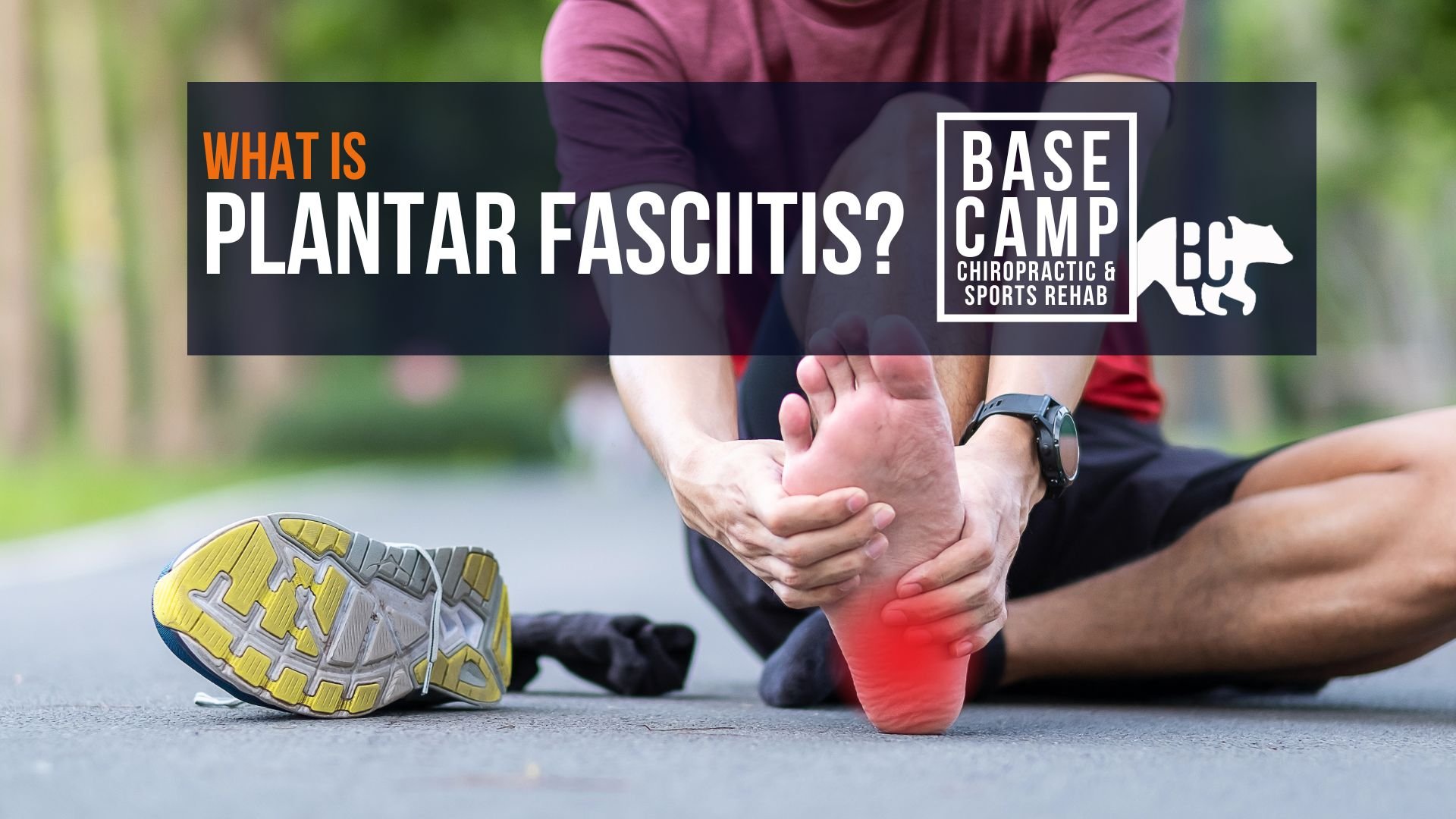plantar fasciitis
Is this you?
This weekend you had a long run. The spring is here! With the sunshine back, you are motivated and inspired to get outside and cruise some longer distances. It feels great to run in the sun!
But…
This morning you woke up, like any other morning, stepped out of bed looking forward to your morning coffee but BAM!
Did you step on something??? Holy smokes! It feels like you are walking on GLASS! The first five steps are the worst. Then it backs off a bit.
Uh oh…
You’ve heard of this before. Your running mate had this last year and is just now getting back to running…
Is this the dreaded PLANTAR FASCIITIS?
Let’s talk about it.
Most runners have heard about Plantar Fasciitis. It is a dreaded injury that can sideline your running season.
Truly, a pain in the foot…
Specifically the heel.
WHAT IS PLANTAR FASCIITIS?
To understand plantar fasciitis, let’s talk about what FASCIA is and then specifically the PLANTAR FASCIA
FASCIA is connective tissue. It runs throughout the body and encases our muscles and joints. It is super important for the structure of our muscles and joints. One of its primary functions is transferring force along the kinetic chain. In this case, we are talking about the posterior chain, which runs from the bottom of your foot all the way up to the back of your hip and beyond.
Think of the fascia in your feet as a strong, stretchy band that runs along the bottom, kind of like a rubber band. When you run, this fascia helps support your arches and absorbs the shock from each step you take. But sometimes, especially if you've increased your running a lot, this fascia can get irritated and sensitized.
It's like if you keep pulling on that rubber band too much, it might start to get sore and swollen. When your plantar fascia gets inflamed, it can feel like a sharp pain in your heel or along the bottom of your foot, especially when you first step out of bed in the morning.
The PLANTAR FASCIA is an especially thick section of fascia that runs from your heel to the ball of your foot. It is SUPER STRONG and helps absorb and transfer force every step while running and walking. When we step and load the foot, the plantar fascia stretches while the arch of the foot lengthens. Along with the muscle of the foot, the plantar fascia keeps the arch from collapsing, while making us more efficient walkers/runners.
In PLANTAR FASCIITIS, the origin point of the plantar fascia becomes irritated and VERY painful. A common belief is that the fascia becomes inflamed, but this actually is not true! It’s more accurate to say that the plantar fascia and the nerves around it are irritated, but not necessarily inflamed.
WHAT CAUSES PLANTAR FASCIITIS (plantar heel pain)?
Like any running injury, plantar fasciitis can be caused by running too much too soon. When the amount of activity you do exceeds the amount of activity you can recover from, it can cause plantar fasciitis (or other running injuries!).
But… plantar foot pain is common in people who don’t run. This means that running alone isn’t the cause of plantar fasciitis. The plantar fascia is loaded in running, walking, and even standing. We see plantar fascia pain in people who stand or walk a lot for work, sedentary people, and people with higher BMI (body mass index).
It is possible to have plantar fascia pain without an increase in running volume, but in active people we usually see a pattern of increased activity leading to symptoms!
A big issue with plantar foot pain is that once we ring that bell, it can be really hard to settle. It is important to get on top of it early to keep it from becoming a larger, more debilitating issue!
HOW DO WE DIAGNOSE PLANTAR FASCIITIS?
If you work with a Sports Chiropractor or Physiotherapist in Vernon, we will do a thorough history and physical exam. The combination of these will tell us if this is plantar fasciitis or something else.
In the physical exam, we will test the foot and plantar fascia to see if it fits classic plantar fasciitis. If not? It may be coming from somewhere else entirely (more on this later!)
HOW DO WE TREAT PLANTAR FASCIITIS?
Treating running-related injuries is simple, but not always easy.
We need to take three steps to get you back running without plantar fasciitis coming right back.
RESET: managing pain, while removing or modifying the things that are causing the symptoms in the first place. This typically involves a period of RELATIVE rest (decreases running, but not always eliminated).
RESTORE: improve mobility, strength, and endurance to prepare you for returning to running at the volume and intensity that you want to be at. This means specific and progressive exercises to strengthen your feet!
RELOAD: get back to running at the volume and intensity you were before the injury!
Treatment options for PLANTAR FASCIITIS
Forget about icing and popping anti-inflammatories for long-term relief. We're not dealing with a classic inflammation scenario here. While rolling your foot on a frozen water bottle or lacrosse ball might offer some relief, it's not the main game plan for treating plantar fasciitis. We're not out to break up scar tissue or change your foot's structure either. If rolling feels good and fits into your rehab strategy, go for it, but it's not a must-do.
Manual Therapy
At Base Camp, we often use muscle work, scraping, taping, and joint adjusting to decrease pain. You can also use some self-myofascial manipulation using a ball to roll out the bottom of your foot or calf. It’s important here to know that this IS NOT a NO PAIN NO GAIN scenario. Less is more when it comes to rolling out your foot and calf.
Changing footwear and/or heel lift
Footwear can temporarily change your symptoms. Using a shoe with more cushion, and a heel lift, can decrease the tension on the plantar fascia.
Stretching
Stretching out the bottom of the foot and the plantar fascia as soon as you wake up, before and after activity, and as a pain control method can be helpful. Try this tried and true plantar fascia stretch
Foot Strengthening
Strengthening a few muscles in the foot, ankle and calf can support the plantar fascia. Here are a few I give a lot (videos at the bottom of this section):
Toe Yoga
Foot Doming
Calf Raises
Then what?
Runners Injury Purgatory.
Where most people fall short is when trying to return to running. They return too soon, without a progressive plan. After a plantar fascia injury, you need to take your return to running slowly and progressively.
Just because the pain is gone, does not mean you are ready to run.
Returning to running too early or at an intensity you are not ready for can land you in the dreaded RUNNERS INJURY PURGATORY!
This is when you repeatedly get injured from running every time you try and start again.
In order to avoid that, a well-structured walk-run program is key!
This is equally important if you have an active goal that is not running.
Using progressive exercise is the best way to get you back to doing your activity without plantar fascia pain coming back.
But… what if it isn’t even plantar fasciitis in the first place?
Plantar fasciitis is WAY over diagnosed.
Every season I see patients come in who have been suffering from plantar fasciitis for months, throwing every treatment they can think of at the foot and getting nowhere, just to find out… it was never plantar fasciitis to begin with.
If your pain is NOT:
WORST in the MORNING with the first few steps
Improving after sitting, only to come right back when you stand up
…and if your pain IS:
WORSE at the end of the day
WORSE with sitting
INCREASING with walking
INCREASING when your lower back pain gets worse
DULL/ACHY/TINGLING/BURNING and never SHARP…
Then your pain might not be related to the plantar fascia in the first place! This is why it is important to get assessed by a clinician who works with foot and ankle injuries, so that you can have confidence you are on the right path!
If your clinician or doctor tells you to:
Get orthotics
Ice your foot
Take ani-inflammatories
or change your footwear…
..without assessing your ankle, knee, hip and lower back… then there is a chance you are being treated for plantar fasciitis, when that is not even the issue!
Dr Mark Murdoch is a runner, chiropractor, and rehab specialist in Vernon, BC.
Every week he works with runners, mountain bikers, and adventure athletes who want to get back to their sport better than ever.
Request a free consult with him here: CONTACT



